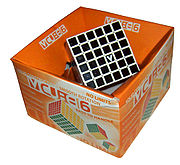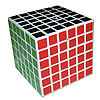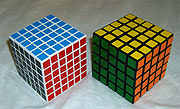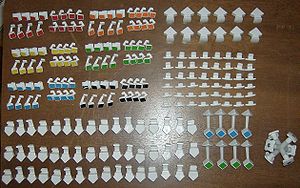
V-Cube 6
Encyclopedia

Rubik's Cube
Rubik's Cube is a 3-D mechanical puzzle invented in 1974 by Hungarian sculptor and professor of architecture Ernő Rubik.Originally called the "Magic Cube", the puzzle was licensed by Rubik to be sold by Ideal Toy Corp. in 1980 and won the German Game of the Year special award for Best Puzzle that...
. Unlike the original puzzle (but like the 4×4×4 cube
Rubik's Revenge
The Rubik's Revenge is the 4×4×4 version of Rubik's Cube. Invented by Péter Sebestény, the Rubik's Revenge was nearly called the Sebestény Cube until a somewhat last-minute decision changed the puzzle's name to attract fans of the original Rubik's Cube...
), it has no fixed facets: the center facets (16 per face) are free to move to different positions. It was invented by Panagiotis Verdes and is produced by his company, Verdes Innovations SA.
Methods for solving the 3×3×3 cube work for the edges and corners of the 6×6×6 cube, as long as one has correctly identified the relative positions of the colors — since the center facets can no longer be used for identification.
Mechanics


V-Cube 7
The V-Cube 7 is the 7×7×7 version of Rubik's Cube. It was invented by Panagiotis Verdes and is produced by his company, Verdes Innovations SA. Like the 5×5×5, the V-Cube 7 has both fixed and movable center facets.- Mechanics :...
uses essentially the same mechanism, except that on the latter these hidden pieces (corresponding to the center rows) are made visible.
There are 96 center pieces which show one color each, 48 edge pieces which show two colors each, and eight corner pieces which show three colors. Each piece (or quartet of edge pieces) shows a unique color combination, but not all combinations are present (for example, there is no edge piece with both red and orange sides, since red and orange are on opposite sides of the solved Cube). The location of these cubes relative to one another can be altered by twisting the layers of the Cube 90°, 180° or 270°, but the location of the colored sides relative to one another in the completed state of the puzzle cannot be altered: it is fixed by the distribution of color combinations on edge and corner pieces.
Currently, the V-Cube 6 is produced with white plastic as a base, with red opposite orange, blue opposite green, and yellow opposite black. One black center piece is branded with the letter V. Verdes also sells a version with black plastic and a white face, with the other colors remaining the same.
Unlike the rounded V-Cube 7, the V-Cube 6 has flat faces. However, the outermost pieces are slightly wider than those in the center. The center four rows are approximately 10 mm (0.393700787401575 in) wide, whereas the outer two are approximately 13 mm (0.511811023622047 in) wide. This subtle difference allows the use of a thicker stalk to hold the corner pieces to the internal mechanism, thus making the puzzle more durable.
Permutations

Any permutation of the corners is possible, including odd permutations. Seven of the corners can be independently rotated, and the orientation of the eighth depends on the other seven, giving 8!
Factorial
In mathematics, the factorial of a non-negative integer n, denoted by n!, is the product of all positive integers less than or equal to n...
×37 combinations.
There are 96 centers, consisting of four sets of 24 pieces each. Within each set there are four centers of each color. Centers from one set cannot be exchanged with those from another set. Each set can be arranged in 24! different ways. Assuming that the four centers of each color in each set are indistinguishable, the number of permutations is reduced to 24!/(4!6) arrangements. The reducing factor comes about because there are 4! ways to arrange the four pieces of a given color. This is raised to the sixth power because there are six colors. The total number of center permutations is the permutations of a single set raised to the fourth power, 24!4/(4!24).
There are 48 edges, consisting of 24 inner and 24 outer edges. These cannot be flipped (because the internal shape of the pieces is asymmetrical), nor can an inner edge exchange places with an outer edge. The four edges in each matching quartet are distinguishable, since corresponding edges are mirror images of each other. Any permutation of the edges in each set is possible, including odd permutations, giving 24! arrangements for each set or 24!2 total, regardless of the position or orientation any other pieces.
Assuming the cube does not have a fixed orientation in space, and that the permutations resulting from rotating the cube without twisting it are considered identical, the number of permutations is reduced by a factor of 24. This is because the 24 possible positions and orientations of the first corner are equivalent because of the lack of fixed centers. This factor does not appear when calculating the permutations of N×N×N cubes where N is odd, since those puzzles have fixed centers which identify the cube's spatial orientation.
This gives a total number of permutations of

The entire number is 157 152 858 401 024 063 281 013 959 519 483 771 508 510 790 313 968 742 344 694 684 829 502 629 887 168 573 442 107 637 760 000 000 000 000 000 000 000 000 (around 157 novemdecillion on the long scale
Names of large numbers
This article lists and discusses the usage and derivation of names of large numbers, together with their possible extensions.The following table lists those names of large numbers which are found in many English dictionaries and thus have a special claim to being "real words"...
or 157 septentrigintillion on the short scale).
One of the black center pieces is marked with a V, which distinguishes it from the other three in its set. This increases the number of patterns by a factor of four to 6.29×10116, although any of the four possible positions for this piece could be regarded as correct.

Solutions
There are a number of methods that can be used to solve a V-Cube 6. The layer by layer method that is often used for the 3×3×3 cube can be used on the V-Cube 6. One method is to first group the center pieces of common colors together, then to match up edges that show the same two colors. Once this is done, turning only the outer layers of the cube allows it to be solved like a 3×3×3 cube. However, certain positions that cannot be solved on a standard 3×3×3 cube may be reached. For instance, a single quartet of edges may be inverted, or the cube may appear to have an odd permutationPermutation
In mathematics, the notion of permutation is used with several slightly different meanings, all related to the act of permuting objects or values. Informally, a permutation of a set of objects is an arrangement of those objects into a particular order...
(that is, two pieces must be swapped, which is not possible on the 3×3×3 cube). These situations are known as parity errors, and require special algorithms to be solved.
Another similar approach to solving this cube is to first pair the edges, and then the centers. This, too, is vulnerable to the parity errors described above.
Other methods solve the cube by solving a cross and the centers, but not solving any of the edges and corners not needed for the cross, then the other edges would be placed similar to the 3x3 Fridrich method.
Some methods are designed to avoid the parity errors described above. For instance, solving the corners and edges first and the centers last would avoid such parity errors. Once the rest of the cube is solved, any permutation of the center pieces can be solved. Note that it is possible to apparently exchange a pair of face centers by cycling 3 face centers, two of which are visually identical.
Records
The current world record for the V-Cube 6 is held by Feliks ZemdegsFeliks Zemdegs
Feliks Zemdegs is an Australian Rubik's Cube speedsolver. The surname is Latvian.He bought his first cube in April 2008 inspired by speedcubing videos and tutorials on Youtube. The first unofficial time he recorded was an average of 19.73 seconds on 14 June 2008...
of Australia with a time of 1 minute 56.96 seconds, set at the Australian Nationals 2011. The best average record is held by Kevin Hays of the USA with a time of 2 minutes 9.03 seconds, set at the US Nationals 2011.
See also
- Pocket CubePocket CubeThe Pocket Cube is the 2×2×2 equivalent of a Rubik's Cube. The cube consists of 8 pieces, all corners.-Permutations:...
(2×2×2) - Rubik's CubeRubik's CubeRubik's Cube is a 3-D mechanical puzzle invented in 1974 by Hungarian sculptor and professor of architecture Ernő Rubik.Originally called the "Magic Cube", the puzzle was licensed by Rubik to be sold by Ideal Toy Corp. in 1980 and won the German Game of the Year special award for Best Puzzle that...
(3×3×3) - Rubik's RevengeRubik's RevengeThe Rubik's Revenge is the 4×4×4 version of Rubik's Cube. Invented by Péter Sebestény, the Rubik's Revenge was nearly called the Sebestény Cube until a somewhat last-minute decision changed the puzzle's name to attract fans of the original Rubik's Cube...
(4×4×4) - Professor's CubeProfessor's CubeThe Professor's Cube is a mechanical puzzle, a 5×5×5 version of the Rubik's Cube. It has qualities in common with both the original 3×3×3 Rubik's Cube and the 4×4×4 Rubik's Revenge, and knowing the solution to either can help when working on the 5×5×5 cube....
(5×5×5) - V-Cube 7V-Cube 7The V-Cube 7 is the 7×7×7 version of Rubik's Cube. It was invented by Panagiotis Verdes and is produced by his company, Verdes Innovations SA. Like the 5×5×5, the V-Cube 7 has both fixed and movable center facets.- Mechanics :...
- (7×7×7) - Combination puzzlesCombination puzzlesA combination puzzle, also known as a sequential move puzzle, is a puzzle which consists of a set of pieces which can be manipulated into different combinations by a group of operations. The puzzle is solved by achieving a particular combination starting from a random combination...

